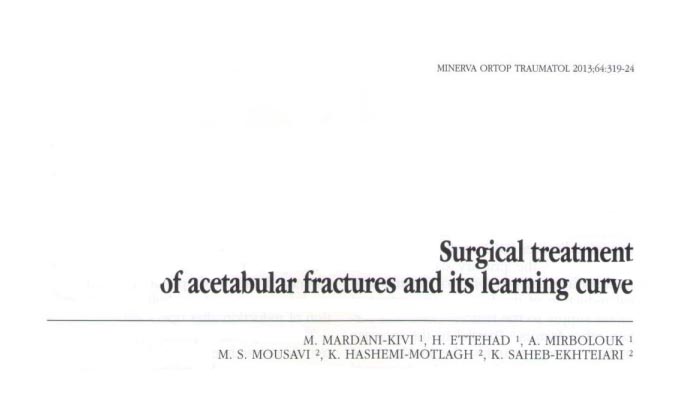- تاریخ درج : ۲۹ فروردین ۱۳۹۶
- تعداد بازدید: 2730
- نویسنده : dr.mohsen mardani-kivi
-

Aim: Treatment of acetabular fractures is very challenging to the orthopedic surgeons who do not have the relevant experience. The present study seeks to evaluate the outcome of the surgical treatment of acetabular fractures and its learning curve .
Methods: A cross-sectional interpretative study was conducted on 104 patients with mean age of 33.28 (17-60) undergoing surgery of acetabular fractures with the mean follow-up of 23 months. Data related to postoperative complications, accompanied lesions, radiographic and functional information of the hip were analyzed. To find out the learning curve, the study was divided into two periods: the first two years with 50 patients and the second two years with 54 patients .
Results: The mean surgery duration was 91.9 minutes in the first period and 74.62 in the second period (P<0.0001). The mean volume of blood infusion was 1.78 in the first period and 1.4 in the second period (P=0.171). The mean Harris Hip Grade, was 84.3 in the first period and 88.38 in the second (P=0.059). The clinical functioning of the hip, in the first period, was excellent in 18, good in 17, fine in 10 and weak in 5 and in the second period was excellent in 27, good in 16, fine in 10 and weak in 1 (P=0.226). Thromboemboli was observed in 3 patients in the first period and 2 in the second (P=0.67). Deep infection was observed in 2 patients in the first period and 1 in the second (P=0.607). Avascular necrosis of the femoral head was observed in 14 patients in the first period and 13 in the second (P=0.662). Postoperative sciatic nerve lesions were observed in 7 patients in the first period and 4 in the second (P=0.19) .
Conclusion: Surgical experience plays an essential role in the outcome of the surgery of acetabular fractures and reduces complications .
-